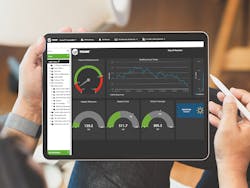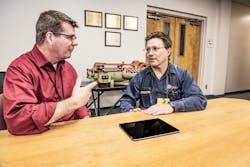How to Maintain Constantly Evolving Smart Buildings
When we look at the future of building systems, it is no longer static. Owners now expect access to the latest building data, automation, and technology.
As a result, modern building systems must support devices from yesterday, today, and tomorrow. So let's explore considerations for maintaining continuously evolving smart buildings to achieve optimal results.
According to the Building Services and Research Information Association (BSRIA), “only 1-2% of commercial buildings [today] deploy truly cutting-edge smart technologies with fully integrated products and services.” So, with global revenue attributed to building automation systems (BAS) expected to increase a total of 4.5% compounded annually over the next 10 years, there is immense opportunity to deliver greater connectivity and intelligence to the existing built environment.1
Smart buildings, of course, leverage connected technologies and intelligence to continually optimize performance.
Today, engineers are increasingly relied upon as strategic collaborators guiding decision-making through the design and implementation of a smart building solution. But with every building at a different point in its lifecycle and owners having a variety of goals, knowing where to start can be challenging.
So, an engineer can best support the evolution of a smart building when an owner’s strategic needs and business goals are well understood. From there, a tailored approach can be created to keep the budget, timeline, and current environment at the forefront of a proposed solution.
With that in mind, it is time to stop talking only about the advances of smart building technology and to start talking about the outcomes the smart building can and will achieve.
Many factors influence building system decisions, from market trends like energy efficiency and decarbonization, to technology trends like cloud services and cybersecurity. Everyday demands tied to productivity, lack of skilled labor, and meeting financial and ESG goals must be factored in. Consider multiple angles and chase outcomes, as opposed to chasing technology. An engineer’s goal should be to design a system that supports devices from yesterday, today, and tomorrow.
Integrating many technologies
It is common for buildings to have controls and equipment from different vintages and a variety of building communication protocols. So integration flexibility is key.
Integration flexibility accommodates the use of existing technologies and paves the way for more smart building growth in the future. It enables data-driven decision-making and serviceability. Designing a system with robust, open, standard protocol communications like BACnet Secure Connect can lay the groundwork for future technology growth and support the process by following IT best practices.
Additionally, leveraging both wired and wireless technologies can simplify implementation and connect to existing infrastructure -- without pulling new wire. Together, these create an infrastructure that is reliable, cost-efficient, and easy to upgrade, while also allowing for the secure deployment of IoT devices and cloud connectivity without IT security dependence.
Most facilities are managing many priorities, such as meeting codes, standards, guidelines, energy efficiency goals, and following local legislation. As a result, automation is required to coordinate the mechanical HVAC and other complementary systems. Taking a phased approach with a proper system design will support automation and optimization, without requiring everything in the building to be replaced.
So, it is key to work with a dependable contractor to help balance these inputs and deliver consistency.
Of course, while an engineer can design the most optimal system, it is eventually handed off to the operator for daily use. Operators must understand the system and its complexities to achieve optimal performance. Toward that end, comprehensive help, training, documentation, and system safeguards can improve daily operations and minimize inefficiencies.
System maintenance is the last piece to the puzzle for maintaining a continuously evolving smart building.
Complex systems need ongoing hardware and software updates by trained technicians to benefit from evolving technology. Informing owners about the expectations and best practices for responsibly managing their assets will set them up for long-term success and build a trusting relationship. A reliable maintenance plan with a trusted service partner will keep the system that you designed in operation for years to come.
As technology rapidly evolves, keeping a pulse on smart building trends and advances will help you deliver the best outcomes on projects and provide the best results for your customers.
1 Guidehouse Insights Market Data on Building Automation and Controls.
##########
About the authors
Brian Meyers is the System Controls Portfolio Leader for Trane Commercial HVAC Americas, based in White Bear Lake, MN. His primary responsibility is the management of current generation Tracer Building Automation Systems. Meyers also serves as a subject matter expert on topics including HVAC applications, system/protocol integration, Internet connectivity & Cyber Security.
Chris Gist is the Unit Controls Portfolio Leader for Trane Commercial and leads the organization’s efforts on new controls product development and the introduction of technological enhancements across Trane’s HVAC portfolio. He has worked more than 22 years in energy services and controls.
About the Author
Brian Meyers
System Controls Portfolio Leader - Trane Commercial HVAC Americas
Brian Meyers is the System Controls Portfolio Leader for Trane Commercial HVAC Americas, based in White Bear Lake, MN. His primary responsibility is the management of current generation Tracer Building Automation Systems. Meyers also serves as a subject matter expert on topics including HVAC applications, system/protocol integration, Internet connectivity & Cyber Security.
Chris Grist
Unit Controls Portfolio Leader - Trane Commercial HVAC Americas
Chris Gist is the Unit Controls Portfolio Leader for Trane Commercial and leads the organization’s efforts on new controls product development and the introduction of technological enhancements across Trane’s HVAC portfolio. He has worked more than 22 years in energy services and controls.


